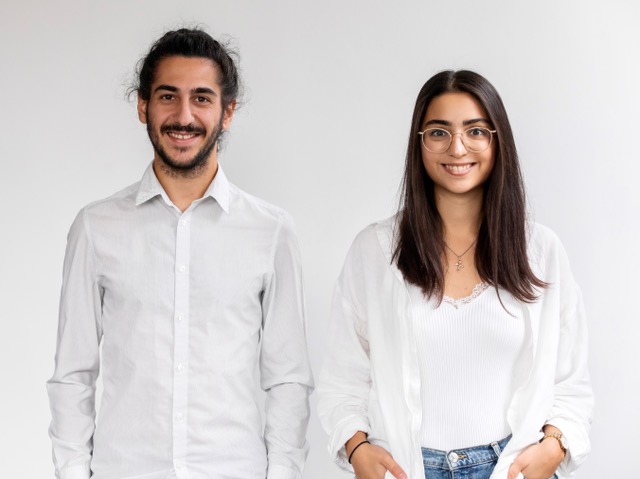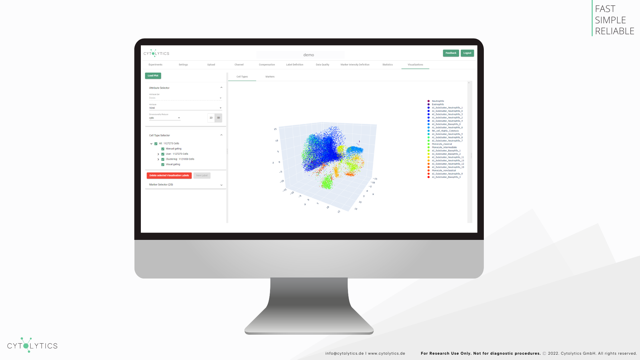Cytolytics GmbH
Bioinformatics meets medical diagnostics and drug development
The start-up company Cytolytics from Tübingen has developed a robust and user-friendly software platform that uses machine learning for the automated analysis of cells. This is beneficial in areas such as cancer diagnostics and the development of new pharmaceutically active substances.
Can Pinar is the CEO and one of the founders of Tübingen-based Cytolytics GmbH. When he was a university student, the bioinformatician was already interested in medical issues and specifically cancer research, a discipline that involves the daily analysis of cancer cells and comparing them with cells from healthy tissue. Flow cytometry is an important tool in this field. It consists of suspending cells in a liquid medium that are then pushed through narrow passages in the flow cytometer one by one, making it possible to analyse individual cells with a laser beam. The laser beam refracts and scatters, thus providing information on the size and structure of the individual cells, and ascertaining whether the cells exhibit certain characteristics, such as surface markers, that only occur in certain types of cancer.
 Can and Serina Pinar focus on both the industrial and academic research markets with Cytolytics. © Uta Wagner
Can and Serina Pinar focus on both the industrial and academic research markets with Cytolytics. © Uta WagnerThe method is now so sophisticated and fast that huge amounts of data can be obtained. However, it is almost impossible to evaluate this data manually. This is where bioinformatics comes into play. Back when Can was doing his undergraduate thesis, he developed workflows for the automated analysis of flow cytometric data as he explains: "Flow cytometry has been around since the 1960s, but until now no platform has been developed for rapid, automated data analysis. In laboratories, users often still manually dig through a lot of data, then filter out cells of interest on a more or less subjective basis."
Can wanted to change this. The more he talked about his idea with researchers and doctors, the clearer it became to him that a platform for automated data analysis would meet a real need in medicine and offer economic potential. Can was also attracted by the versatility of the task. "Flow cytometry is very commonly used in cancer diagnostics. But the method is also very helpful in the development of medically active ingredients, which also requires constant analysis of cells – be it for application in the treatment of cancer, infections or countless other diseases."
Data evaluation independent of specific disease patterns or pathogens
Serina Pinar, Can's wife, was also a member of the founding team in 2020. "Serina is a huge asset to the team, not least because she has a teaching degree and helps to bring the product closer to customers. Among other things, she is responsible for the 'meducational content' and is now COO of the company," Can explains.
 It is important to Cytolytics that the user interface of the evaluation software is clear and intuitive. It is internet and browser compatible and can be installed as an app. © Cytolytics GmbH
It is important to Cytolytics that the user interface of the evaluation software is clear and intuitive. It is internet and browser compatible and can be installed as an app. © Cytolytics GmbHIn addition to their software expertise, the team uses state-of-the-art methods that these days can be used in product development thanks to artificial intelligence. "Machine learning is a key feature of our company. We work with ‘unsupervised learning’. This means we do not train the system by feeding it data in advance. This can lead to discoveries that would otherwise not be possible," says the bioinformatician. He illustrates this using the famous saying about comparing apples and pears: "If you train the software with highly diverse data on apples and pears, it gets better and better at recognising apples and pears, but will not be able to find intermediate classes such as apple and pear hybrids. We do not want to introduce bias by saying this or that is an apple." Applied to cancer cells, machine learning could help identify specific cancer cells even if they do not carry a typical surface marker. "Take CD3 for example. CD3 is a typical T cell marker. In our approach we do not present the CD3 marker to the system in advance. This helps us to find alternative characteristics and ways to identify T cells."
In the Cytolytics platform, algorithms in the background ensure that an ongoing categorisation, i.e. data clustering, takes place. The system thus learns from the experience it generates itself. Whether or not the system is in fact able to identify a particular cell group, such as the T cells in the aforementioned example, can in each case be verified with appropriate controls. In 2022, the Cytolytics team, back then with a staff of ten, was still focused on the industrial and academic research market. "We want to provide researchers with a tool that they can use to advance cutting-edge research," says Can, adding that the team is already working on obtaining national and international approvals for their platform for use in diagnostic applications. In around one or two years, the team hopes to be ready and to have at least acquired the CE mark for its product.
Focus on diagnostic and therapeutic applications
Cytolytics not only works hard to optimise actual data analysis, but also to deliver the results to the user as quickly as possible and ensure they are easy to understand. "We place a lot of emphasis on modern software with user experience. This means that using the platform should feel natural and self-explanatory," says Can. The result is a cloud-based web application operated via a specially developed app. "Since IT security is very important to us, we chose a cloud provider in Germany through which users can upload their data to the web platform," he explains.
Thanks to funding from Baden-Württemberg government’s ‘Start-up BW’ programme, the company was able to raise initial capital as early as 2020. The founders are now thinking about a first large seed financing round, which they hope to launch in 2023. The team still sees a lot of potential for further development of the company: "In the long term, we would also like to expand the platform to other disciplines within the life sciences. We also envisage being able to evaluate proteomic analyses with flow cytometry as well as using it in the context of RNA sequencing, for example," says Can, highlighting the company’s future goals.